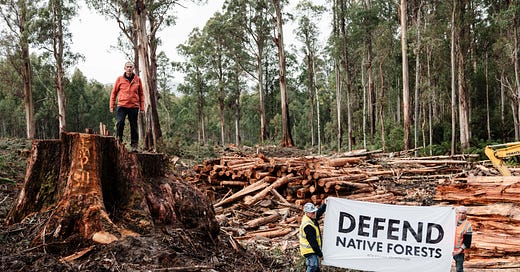Environmentalism is Resistance
and biodiversity loss is the biggest driver of infectious disease outbreaks
Dear activists,
It’s not every day you meet one of your heroes.
A bit over a month ago, I had the privilege of sitting and speaking with Bob Brown. As an Australian, Bob was a prominent public figure throughout my life. His actions and words inspired my own and encouraged me to become the person I am today.
For anyone who doesn’t know who Bob Brown is, this week’s story will ensure you do. Scroll down to read about the life and work of one of Mother Earth’s great defenders.
🗞️ In Climate News
🇮🇩 Desperation sets in for Indigenous Sumatrans who lost their forests to plantations
♶ At its fourth summit, 170 nations strive toward a global plastics treaty by 2025
🇰🇪 Kenya: Anger and frustration as floods continue to wreak havoc
🇻🇳 Hundreds of thousands of fish die off in Vietnam as heatwave roasts Southeast Asia
🇧🇷 New ban threatens traditional fishers in Brazil’s Mato Grosso state
🇱🇷 New illegal logging threatens Liberia’s forests amid vague ban
🗺️ Climate change is pushing animals closer to humans, with potentially catastrophic consequences
🏥 Biodiversity loss is biggest driver of infectious disease outbreaks, says study
🇻🇪 Venezuela loses its last glacier as it shrinks down to an ice field
🌎 Disease and hunger soar in Latin America after floods and drought
🇦🇺 Australia commits to gas beyond 2050 despite climate warnings
📈 Cool Trends
♾️ eco-story
Environmentalism is Resistance
Depending on how you define it, activism has a long history in so called Australia.
When Arthur Phillip — a former whaler and longtime servant of the British Navy — attempted to establish a colony on Gadigal land, he was resisted by Bennelong, Pemulwuy and the many Eora people who fought beside them. The Colony was established in the settlement of Sydney Cove, and early settlers invaded the nearby land of the Dharawal, Dharug, Awabakal, Darkinjung, Gandangara and Wiradjuri peoples. The fifth Governor of New South Wales, Lachlan Macquarie, effectively declared war on the “hostile natives”. Communities were massacred and native forests were felled, as settlements spread with the support of British agriculture and grazing methods that were imposed on the land. The Original Peoples of the Sovereign Nations that criss-cross the Australian continent and its surrounding islands, resisted an onslaught of violence and terror for over 100 years through a series of conflicts commonly referred to as the Frontier Wars. Musquito, Yagan, Windradyne, Tarenorerer, Tunnerminnerwait, Maulboyheenner, Truganini, Jandamarra and Dhakiyarr are some of the many figures of resistance who fought alongside their respective communities.
Eventually the colonies of New South Wales, Van Diemen’s Land, Port Phillip, Swan River, South Australia and Queensland united to form the Commonwealth of Australia. Resistance continued as communities continued to live in the face of the restrictions imposed on their culture and connection to Country by the newly formed state and federal governments. Foreign settlers also resisted British rule and imposition, reflected in the Rum Rebellion of 1808 and the Eureka Stockade of 1854, as well as the development of labour unions throughout the colonies in the 19th century.
Unionism also influenced the development of the first politically organised Aboriginal activist group, the Australian Aborigines Progressive Association (AAPA), formed in 1924, campaigning for rights to land ownership, citizenship, control of their own affairs and an end to the removal of Aboriginal children from their families. The AAPA was renamed the Aborigines’ Progressive Association and along with the Australian Aborigines League, they organised the first Day of Mourning on January 26 1938. It was the culmination of years of work, encouraging Aboriginal and Torres Strait Islander activism across Australia, which led to the Yirrkala Bark Petitions, the Freedom Ride, the Wave Hill walk-off, the campaign for the constitutional referendum of 1967, the Aboriginal Tent Embassy and the Mabo Case.
🌏 The Culture Column
📺 What we’re watching: The Giants
📸 Profile of the week: @bobbrownfoundation
📖 What we’re reading: Optimism: Reflections on a Life of Action, by Bob Brown
🤯 Shocking fact we learnt this week: Tasmania has the oldest trees in the world: While the oldest individual tree or stem on the site may now be 1000 to 2000 years old, the organism itself has been living there continuously for 10,500 years.





